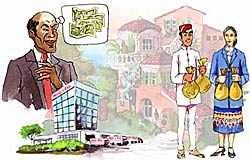|
The IMF In Action: Why Do We Need the IMF?
Summary
 In this activity, students take the role of a cell phone salesperson in a mythical country.
They are asked to choose between alternative solutions in a series of scenarios
about trade issues. In the course of their decision-making, they learn how the IMF provides assistance to countries with currency problems.
In this activity, students take the role of a cell phone salesperson in a mythical country.
They are asked to choose between alternative solutions in a series of scenarios
about trade issues. In the course of their decision-making, they learn how the IMF provides assistance to countries with currency problems.
Audience
14-18 year olds (9-12 graders, US) studying Social Studies and Economics in school.
National Economics Content Standards
Standard 10 — Role of Economic Institutions
Institutions evolve in market economies to help individuals and groups accomplish their goals. Banks, labor unions, corporations, legal systems, and not-for-profit
organizations are examples of important institutions. A different kind of institution, clearly defined and well-enforced property rights, is essential to a market
economy.
Standard 11 — Role of Money
Money makes it easier to trade, borrow, save, invest and compare the value of goods and services.
Warm-up Activities
- Ask students who have visited other countries what kinds of currencies they used. List the names of the other currencies on the board.
- Divide the class into groups of 4 students. Give each group daily exchange rate tables (found in the business section of most major newspapers) for at least 5 days.
Make enough copies so that each group has one table from each day. Have student compare the exchange rate of one foreign currency for the five days. (For example,
how many Japanese Yen were needed to buy one U.S. dollar on Monday, Tuesday, Wednesday, Thursday and Friday?) Guide students to recognize that exchange rates
fluctuate from day to day.
- Explain that exchange rates change as the demand for a currency changes. Demand for a currency increases when the demand for goods and services from that country
increases. If a country is producing cars that lots of people want to buy, then demand for that country's currency will increase, and the value of the currency
will increase.
Lesson Applications
Divide the class into two groups, Country R and Country B. Distribute red construction paper strips randomly to the students in Country R and blue construction paper
strips randomly to the students in Country B. Country R produces lima beans and charges 5 R per bean; Country B produces elbow macaroni and charges 10 B per noodle.
Set up one desk on each side of the class that will be the "sales center" for that country, and give Country R a container of lima beans and Country B a
container of elbow macaroni. Consumers in Country B wants to buy beans, but they have no Red currency. Consumers in Country R want to buy macaroni, but they have
no Blue currency. An exchange service is needed.
Set up an exchange "bank" at one desk, and choose a student to be the "banker." Give the banker a stack of R and a stack of B currency. The rate of
exchange is 1R = 2B. Students can now exchange their currency and purchase beans or macaroni.
Ask: "What would happen to the demand for beans if a medical report said eating beans would add ten years to a person's life?" (Demand would increase.)
"What would happen to the demand for B currency?" (It too would increase.) "What would happen to the exchange rate of B currency relative to R
currency?" (It would take more R to buy B.)
Explain that in the scenario above, R currency has appreciated relative to B. B currency has depreciated relative to R.
Additional Resources
Web Link:
Current Currencies. This link presents a lesson plan about money and currency exchange rates. It includes a teacher's plan and a student how-to guide.
http://www.microsoft.com/Education/CurrentCurrencies.aspx
Online Extension Activities:
Choose 8 students who have finished their assigned work and have them, in pairs, evaluate the following lessons and present them to the class.
Globalization Comes to the Table. This lesson deals with globalization, with special emphasis on food production.
http://www.microsoft.com/Education/GlobalTable.aspx
Currency Exchange and the Balance of Trade. This lesson deals with exchange rates and world currencies.
http://www.michigan.gov/scope/0,1607,7-155-13515_13516_13520-84563--,00.html
Why Do We Need the IMF?
EconEd Online |